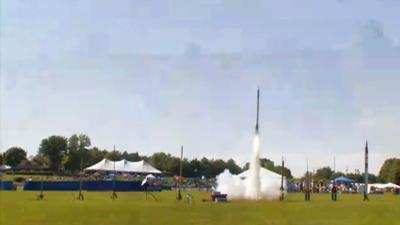TARC Will Engage More Than 700 Student Teams This Year
More than 700 student teams representing 48 states, the District of Columbia and the U.S. Virgin Islands are preparing for the Aerospace Industries Association's 2014 Team America Rocketry Challenge, the world’s largest student rocket contest and a key piece of the aerospace and defense industry’s strategy to build a stronger U.S. workforce in science, technology, engineering and math (STEM).

More than 700 student teams representing 48 states, the District of Columbia and the U.S. Virgin Islands are preparing for the 2014 Team America Rocketry Challenge, the world’s largest student rocket contest and a key piece of the aerospace and defense industry’s strategy to build a stronger U.S. workforce in science, technology, engineering and math (STEM).
The competition challenges each team to design and build a model rocket that can travel to a height of 825 feet and back within 48 to 50 seconds. Each rocket must also deploy two identical parachutes carrying precious cargo — two raw eggs that must return safely to the ground undamaged. Scores are determined by how close they come to the required height and time; damaged eggs disqualify the flight. TARC poses a different challenge each year, and 2014’s dual-parachute requirement combined with the tight timing window and other structural criteria make this contest the most difficult in the competition’s 12-year history.
Sponsored by the Aerospace Industries Association, the National Association of Rocketry and more than 20 industry partners, the contest aims to bolster U.S. student engagement with STEM. In a 2010 survey among TARC alumni, approximately 80 percent of respondents said they planned to pursue a STEM-focused college major.

“We are proud and grateful for the influx of talent TARC has injected into the aerospace and defense industry’s workforce development pipeline since the program’s inception,” said AIA President and CEO Marion C. Blakey. “During a time when America struggles to match our international counterparts in producing sufficient graduates in STEM education fields, TARC has helped thousands of skillful and knowledgeable young people get started on challenging career paths.”
This year’s diverse cohort includes several teams that are utilizing 3-D printers to develop rocket components; a team from Hawaii that hopes to be the first from their state to qualify for the national finals; and a team from Alaska that will spend the winter launching test flights in sub-zero temperatures. The program has also experienced a two percent growth in female participation over the past year and a number of all-girls teams are vying for the chance to compete in the national finals.
Teams have until March 31 to launch and submit their qualifying flight scores. Those within the top 100 will advance to the National Finals on May 10 at Great Meadow in The Plains, VA.
Participants compete for scholarships and prizes totaling $60,000 as well as bragging rights for winning the world’s largest student rocketry competition. The winning team will travel to the Farnborough International Air Show in July courtesy of the Raytheon Company to compete in the International Rocketry Challenge. The American team will face off against teams from the UK and France in hopes of defending the international championship won by Georgetown, Texas 4H last year in Paris.
(Images from previous TARC events)
 ANN FAQ: Contributing To Aero-TV
ANN FAQ: Contributing To Aero-TV ANN's Daily Aero-Linx (05.29.24)
ANN's Daily Aero-Linx (05.29.24) ANN's Daily Aero-Term (05.29.24): NORDO (No Radio)
ANN's Daily Aero-Term (05.29.24): NORDO (No Radio) ANN's Daily Aero-Term (05.30.24): Beyond Visual Line Of Sight (BVLOS)
ANN's Daily Aero-Term (05.30.24): Beyond Visual Line Of Sight (BVLOS) ANN's Daily Aero-Linx (05.30.24)
ANN's Daily Aero-Linx (05.30.24)




